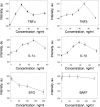Closed-loop control of cellular functions using combinatory drugs guided by a stochastic search algorithm
- PMID: 18356295
- PMCID: PMC2278193
- DOI: 10.1073/pnas.0800823105
Closed-loop control of cellular functions using combinatory drugs guided by a stochastic search algorithm
Abstract
A mixture of drugs is often more effective than using a single effector. However, it is extremely challenging to identify potent drug combinations by trial and error because of the large number of possible combinations and the inherent complexity of the underlying biological network. With a closed-loop optimization modality, we experimentally demonstrate effective searching for potent drug combinations for controlling cellular functions through a large parametric space. Only tens of iterations out of one hundred thousand possible trials were needed to determine a potent combination of drugs for inhibiting vesicular stomatitis virus infection of NIH 3T3 fibroblasts. In addition, the drug combination reduced the required dosage by approximately 10-fold compared with individual drugs. In another example, a potent mixture was identified in thirty iterations out of a possible million combinations of six cytokines that regulate the activity of nuclear factor kappa B in 293T cells. The closed-loop optimization approach possesses the potential of being an effective approach for manipulating a wide class of biological systems.
Conflict of interest statement
The authors declare no conflict of interest.
Figures






References
-
- De Francesco R, Migliaccio G. Challenges and successes in developing new therapies for hepatitis C. Nature. 2005;436:953–960. - PubMed
-
- Sawyer CL. Mixing cocktails. Nature. 2007;449:993–996. - PubMed
-
- Izumi Y, Xu L, di Tomaso E, Fukumura D, Jain RK. Tumor biology—Herceptin acts as an anti-angiogenic cocktail. Nature. 2002;416:279–280. - PubMed
-
- Chesney MA, Ickovics J, Hecht FM, Sikipa G, Rabkin J. Adherence: A necessity for successful HIV combination therapy. AIDS. 1999;13:S271–S278. - PubMed
Publication types
MeSH terms
Substances
Grants and funding
LinkOut - more resources
Full Text Sources
Other Literature Sources
Medical

